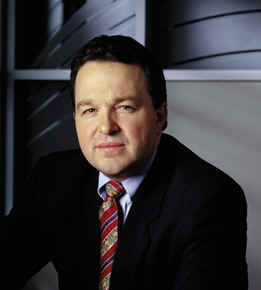|
|
MapInfo Corp. (MAPS) |
|
|
CEOCFO Current
Issue |
This is a printer friendly page! MapInfo Corporation integrates
software, data and services to extract the value of location through their location-based
intelligence and location-based services BIO: Cattini started his professional career at Taylor
Woodrow Services Ltd. and also held technical positions at Beecham Foods Ltd. and
International Software Ltd. He received a B.A. in business studies with honors from Thames
Valley University, London. Location-based intelligence is solving complex
problems in vertical industries such as communications, insurance, financial and
government. Using location-based predictive analytics, MapInfo helps the retail, real
estate, banking and restaurant industries better understand their customers and markets.
MapInfo’s unique location-based services platform, miAware™, enables
the development of unique location-enabled applications, which are critical to carriers
and large enterprise customers needing to differentiate services to retain and attract
customers. MapInfo’s Consulting Services include installation and implementation,
design consultation, custom application development, technical and end user training and
support and maintenance. CEOCFOinterviews: Mr.
Cattini, please tell us about MapInfo when you became its CEO and what changes you have
orchestrated? Mr. Cattini: “MapInfo Corporation integrates software, data and services to extract the value of location from the information. When I became CEO, we were a business that had grown rapidly over the previous three years. Much of the growth was around the telecommunications boom and we were very quick to capitalize on that market opportunity. We had the tools and skills internally to deliver great value. Unfortunately, as I took over, that was beginning to come to an end. I took over as CEO at a time when the market was changing and there was a slow down in information technology spending. We had to make some rapid adjustments to the business. At that point, we were more than 40 percent invested in telecommunications as our customer base and we were representing over $40 million dollars in revenues from this market, which rapidly became $20 million in revenues. When you are a hundred million dollar company, you need to make some rapid adjustments, and we have spent the last two years doing that.” CEOCFOinterviews: How have you changed and what else needs to be done? Mr. Cattini: “We realized the need to diversify our business, not necessarily away from telecommunications, but as well as telecommunications. As we investigated the usefulness of what we did, we found that our value proposition was across multiple market places. In 2002, we began to restructure our company around our customer needs as we understood them. We created three business units that we call “location-based intelligence, predictive analytics and location-based services” and within those, we have some specific vertical focuses. As of the third quarter 2003, telecommunications has gone from more than 40 percent to 21 percent of our business, retail is at 21 percent, up from less than 5 percent and the public sector is at 15 percent. The retail expanse was primarily due to an acquisition that we had targeted as part of our strategy moving forward, and we were able to deliver on that. What we have is vertical teams focused on the way in which location can enhance the business process or provide an insight that you would not otherwise get. We have moved forward in that way, steering our company accordingly.” CEOCFOinterviews: Will you give us an example of what the basics are in the location-based intelligence and where its utilization might surprise people? Mr. Cattini: “In telecommunications, location-based intelligence is about planning, building and visualizing networks, such as what properties or assets you have, where they are and how they relate to your customer base as you see your market place expanding. For example, Sprint (NYSE: FON) has a system that they built on top of technology called “Market Demand Network Planning” where they are planning their network two years ahead. It looks at their customer network, integrating demographics, figuring out what resources they have for that customer base now and in the future. Another example in telecommunications is centered around customer service. A good example would be Orange in the UK, which has over 7000 users. The customer service representatives have maps on their screen that visualize the coverage. When a customer calls in with a complaint or an inquiry about a certain type of service, the performance of network assets at that point in time can be visualized. If you move to the public sector, there is a lot of work around security and law enforcement. For example, The New York Police Department uses our technology and solutions in analyzing crimes. When a crime is recorded, it is just an entry into a database stating what the crime was, who it was against, the witnesses, arresting officer, time of day, and where it occurred. We extract the value “where” by putting those crimes physically on a map and clearly showing where patterns are occurring based on location relevant crime. We are also doing some work around Homeland Security. If you imagine an unfortunate incident, what you need to set up in advance is an awareness program. It consists of identifying which emergency services are in zone one, two or three, what are the control and access points, what are the routes in and out and what are the services available and where they are. Home Depot is one of our largest customers. This is where we start to integrate demographics and segmentation with mapping out and understanding a trade area. The last area is location-based services; this is where we focus on the consumer market place of enabling wireless devices. We built four platforms to be able to deliver those services to four European countries.” CEOCFOinterviews: What is it about the location component that necessitates a special software? Mr. Cattini: “The unique value proposition of what we are able to do is physically relate consumer behavior based on business. We are able to model for a customer exactly how far away the type of customer base they are looking to attract is located and the impact of placing a store in a particular location. For that, you need to know the physical location on the earth’s surface, the latitude and longitude of where the store is potentially going to be, versus the top concentration of customers, this enables you to model how far a certain type of customer is prepared to travel for a certain type of product. You create a trade area, and we would actually model for our customers physically how far you would have to drive to get to the store location. That is taking into consideration the type of road network and traffic intersections.” CEOCFOinterviews: Do you license software for the companies? Mr. Cattini: “With some customers we provide the traditional software model. We provide a license, and also content, which may be the digital maps of the streets or the demographic boundary data, or insurance data. We license that data, but that data gets old because addresses change, and boundaries and demographic profiling will change. What we will provide is an update on an annual basis, as well as services. That is how we go to market; we use our software to deliver reports that provide answers and solve customers’ problems.” CEOCFOinterviews: Are people coming to you now? Mr. Cattini: “When we saw the initial downturn in the tech industry, many companies tried to put technology purchases on hold for as long as possible. We have seen some recent changes in the industry and it is certainly improving.” CEOCFOinterviews: What areas are growing fastest for you? Mr. Cattini: “We are in the process of prioritizing our investments as we move forward and are in a business planning process. One of the key areas we will invest in next year is, for example, Homeland Security where we have been driving solutions that fall into that space for years. The example of modeling of stores and providing valuable demographic data is at the moment, a US centric business and we have already started to explore the possibility of moving that value proposition to Europe.” CEOCFOinterviews: Is there much competition for you? Mr. Cattini: “There is always competition, particularly in the public sector with a company called ESRI, a company that has been in the GIS business for nearly 30 years. In certain other markets we see some competition, such as in the telecommunications with some people providing certain technologies. I think what differentiates us from our competitors in the commercial space is our breadth of offerings. This includes our data and our knowledge of business processes in the industry, where we are able to offer consulting. With Applebee’s (NASD: APPB) it is a question of the expertise of understanding the retail market, and applying tools and technologies to deliver the options that they are looking for to make more informed decisions. Our competitive advantage is that we have a breadth. Individually in certain components is where we see most of our competition.” CEOCFOinterviews: Will you tell us about the current financial position of MapInfo? Mr. Cattini: “The good news, financially, is that we have more than thirty million dollars in cash, and about eighteen million in debt, fifteen million of which is toward building our headquarters in upstate New York. Three million of that debt was used partly to finance the Thompson acquisition in January 2003. We have thirty-two million in cash and the last four quarters we have generated approximately six million in cash flow. We have just become profitable again and on a 24 percent increase in revenues, we have been able to generate three cents. Our balance sheet position is improving.” CEOCFOinterviews: Do you see much difference in the geographic distribution? Mr. Cattini: “Our biggest market has always been the U.S., but we have a very balanced geographic mix. As of fiscal year 2002, we had 46 percent of our revenues outside of the Americas. It is going to be slightly lower this year because of the acquisition of Thompson, which is all Americas based. We have a healthy business of 150 people in Europe, a very strong growth business over the last few years, and a very strong business with high markets in the Asia-Pacific. I think the geographic distribution of our business, helped us during the downturn in the Americas.” CEOCFOinterviews: Do you see more acquisitions or joint ventures going forward? Mr. Cattini: “I think acquisitions are a valid part of business strategy, where it makes sense. If it adds strategic value to the business, gets you to a place quicker than you could get on your own, and gets you to a core customer base quickly, then absolutely! We have a good track-record with acquisitions and we continue to keep our eyes open.” CEOCFOinterviews: In closing, what should investors remember about MapInfo? Mr. Cattini: “We are a hundred million dollar software company that weathered a brutal downturn in the telecommunications and IT spending environment. Two years later we are profitable at the same revenue level and having to restructure our entire business. We have a strong franchise on a global basis with hundreds of thousands of loyal global users. We have steady growth on that core business moving forward. We also have some significant opportunities ahead. Wi-Fi and Homeland Security could be significant for MapInfo. However, we are not counting on explosive growth in any one area. If we see the potential moving forward, we will invest aggressively, like we have done in the past. I think any potential investor should know that we are a company that has weathered the downturn and it has been very tough for software companies our size, and many of them have really struggled as we did, but we are out of it. We are profitable with growth opportunities ahead of us.” disclaimers |
|
To view Releases highlight & left click on the company name!
|
|





